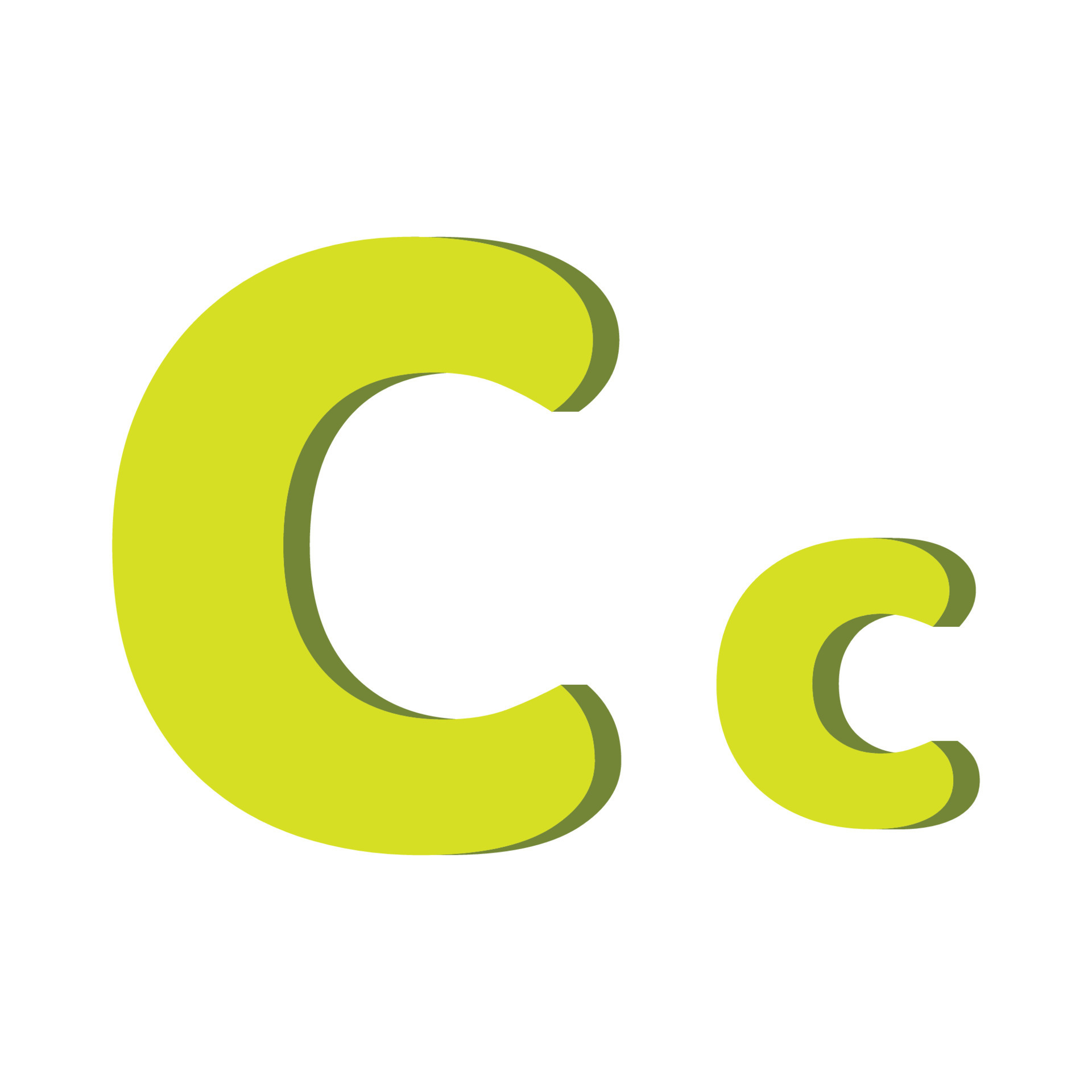When you think about distinct shapes and specific forms, whether it's the gentle sweep of a letter or the precise curve in a design, there’s often a need to understand the subtle differences. It's almost like comparing two very similar things, perhaps the way you might distinguish between a "C" shape and a "D" shape. You know, just a little shift can make for a big difference in how something presents itself or even how it functions.
Sometimes, what seems like a small distinction actually holds a lot of meaning. It's about recognizing the unique characteristics that set one thing apart from another. We often find ourselves looking closely at how things are put together, or how they behave, trying to get a clearer picture of their individual qualities. This kind of careful observation helps us appreciate the nuances, which, you know, can be pretty important.
In a way, this careful examination of shapes and forms, or really, any kind of distinct characteristic, mirrors how we approach many areas of life. We look for patterns, we notice what makes things special, and we try to figure out how everything fits together. So, with that thought in mind, let's explore something that has its own unique structures and very particular ways of doing things, something that has truly shaped a lot of what we interact with every single day.
Table of Contents
- What's the Deal with C, Anyway?
- How Does C Programming Actually Work?
- A Look Back - The Roots of C
- Operators - The Building Blocks of C vs D Curl Logic
- What's the Role of the Compiler and Linker in C vs D Curl?
- How Does Memory Play a Part?
- C's Big Impact - Shaping the Future of C vs D Curl Languages
What's the Deal with C, Anyway?
So, you might have heard about C, or perhaps seen its name pop up in discussions about computers. It's a programming language, that's what it is, and it has been around for quite a while, actually. Think of it as a set of instructions that tell a computer what to do, very precisely. It's a kind of language that operates in a step-by-step fashion, meaning you give the computer commands, one after the other, and it follows them in order. This style is often called "imperative" because you are essentially commanding the machine.
Then there's this idea of it being a "procedural" language. This simply means that you can organize your instructions into chunks, like little recipes, called procedures or functions. It's a bit like having a cookbook where each recipe tells you how to make one part of a meal. You can then call upon these recipes whenever you need them, which, you know, makes things much tidier and easier to manage. This structure, in some respects, helps keep things from becoming too messy, especially when you are building something rather large.
C also has something called "lexical variable scope." This is a fancy way of saying that where you define a piece of information, or a "variable," in your code determines where that piece of information can be used. It's like having different rooms in a house; something in the kitchen might not be visible or usable in the bedroom, unless you bring it there. This helps keep things organized and prevents accidental changes to important data, which is pretty useful when you're trying to keep track of a lot of different bits of information.
And then there's "recursion," which is a really interesting concept. It's when a function, or one of those little recipes we talked about, calls itself. Imagine a set of Russian nesting dolls, where each doll contains a smaller version of itself. That's a bit what recursion is like. It's a powerful way to solve certain kinds of problems, especially those that can be broken down into smaller, similar versions of themselves. It can be a little mind-bending at first, but it's a very clever trick that, you know, programmers often find very handy.
Finally, C uses what's called a "static type system." This means that when you declare a piece of information, you have to tell the computer what kind of information it is right from the start. Is it a whole number? Is it text? Is it a number with decimal places? This is decided before the program even runs, and the computer checks to make sure you're using these pieces of information correctly. It's like having a strict sorting system for your ingredients before you start cooking; everything has its designated place, and the system makes sure you don't accidentally try to mix, say, a word with a number, which could cause a mess, obviously.
How Does C Programming Actually Work?
When we talk about how C programming operates, it's really about taking human-readable instructions and turning them into something a computer can understand and follow. You see, computers don't speak English, or any human language for that matter. They work with very basic signals, like on and off switches. So, the code you write, which looks like words and symbols, needs to be translated. This whole process, you know, is pretty fundamental to making software do anything at all.
The journey of your C code from something you type to something the computer executes involves a few key steps. It's a bit like writing a letter in one language and then having it go through a translator and a mail system before it reaches its destination. First, you write your instructions, your "source code," in the C language. This is what you see on your screen, full of commands and logic that you've put together. This text file is, in a way, the raw material for everything that follows.
Then, a special program steps in, and we'll talk more about it soon. This program takes your C code and checks it for any grammatical mistakes or structural errors. If everything looks good, it translates your human-like instructions into a language that's much closer to what the computer's central processing unit understands. This intermediate form isn't quite ready to run yet, but it's a significant step closer. It's kind of like getting your letter translated into a different language, but it's still just words on a page, not yet delivered.
After that, another process takes over to combine all the different pieces of your program, along with any pre-written code that your program needs to function, into one complete, runnable package. This final package is what the computer can actually open and follow. So, in essence, C programming works by taking your carefully crafted instructions, checking them over, transforming them into a machine-friendly format, and then assembling all the necessary parts so the computer can perform the tasks you've laid out for it. It's a very systematic approach, basically.
A Look Back - The Roots of C
The C programming language has a rather interesting story, going back to the early 1970s. This was a time when computers were, you know, very different from the sleek machines we have today. They were often large, complex, and not nearly as widespread. It was during this period that a couple of really clever people, Ken Thompson and Dennis Ritchie, were working at Bell Labs, a famous research facility. They were trying to make things better, particularly with an operating system they were developing called Unix.
They found that the tools they had weren't quite doing what they needed, especially for building system software. So, they set out to create something new. It's interesting to note that C actually got its name because it followed another language called "B." So, you see, it was a logical progression, kind of like moving from one version to the next, just a little bit of an upgrade. This new language, C, was designed to give programmers a lot of control over the computer's hardware, while still being somewhat easier to write than the very low-level languages that were common at the time.
The work they did to improve Unix using C was a big deal. It showed that you could build powerful and efficient operating systems with this new language, which was a significant step forward. Over the decades since its creation, C has grown to be one of the most widely used computer programming languages out there. It's been a true staple in the programming world for a very long time, and its influence is still felt strongly today. It's pretty incredible how something started in one specific place for one specific purpose can, you know, spread so far and wide.
Here's a little bit about the folks who helped bring C into existence:
| Name | Role in C's Development | Affiliation | Key Contribution |
|---|---|---|---|
| Ken Thompson | Creator of the B language (C's predecessor), early Unix developer. | Bell Labs | Pioneered concepts that led to C, co-created Unix. |
| Dennis Ritchie | Creator of the C language, co-creator of Unix. | Bell Labs | Designed and implemented C, significantly shaped Unix. |
Operators - The Building Blocks of C vs D Curl Logic
Just like how the letter "C" has a distinct curve and "D" has its straight back and rounded front, programming languages have their own unique components that give them shape and allow them to perform actions. In C, and also in its close relative C++, these components are often called "operators." Think of operators as the action words or symbols that tell the computer to do something specific with pieces of information. They are, in a way, the very tools you use to build any kind of logic or calculation.
Operators are what allow you to add numbers together, compare two values, or assign a value to a piece of information. For example, the plus sign (+) is an operator for addition, and the equals sign (=) is an operator for giving a value to something. These are pretty straightforward, you know, but there are many others that do more complex things. Some tables you might see, when looking at lists of these operators, will even have a special column just to show if a particular operator is available in C, since most of them are also present in C++ unless specifically noted otherwise. It's a handy way to keep track of what's available in each language.
Understanding these operators is really key to writing any kind of functional program. They are the tiny instructions that, when strung together, create larger, more meaningful actions. Without them, you couldn't tell the computer to perform calculations, make decisions, or manipulate data. They are, basically, the verbs of the programming world, enabling all the interactions and transformations that happen within your code. So, when you are trying to make sense of how different pieces of data interact, or how one thing compares to another, you're almost certainly going to be using one of these operators to express that relationship, a bit like how the distinct shapes of "C" and "D" help us differentiate them.
What's the Role of the Compiler and Linker in C vs D Curl?
You know, when you're trying to create something, whether it's a piece of art or a complex machine, there are usually steps involved in getting from the raw idea to the finished product. In the world of C programming, two very important tools that help in this transformation are the compiler and the linker. They play crucial roles in taking the human-readable code you write and turning it into something the computer can actually run. It's a bit like having a translator and an assembler working together to


